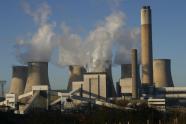Coal is in Transition
Will utilities retire coal units?

Coal is not in crisis. It’s in transition. With a host of regulations building, utilities that operate coal fleets will have to rethink their business strategies: Do they install expensive upgrades or build advanced coal reactors or do they retire their older units and replace them with those fired by natural gas?
The answer is likely to be all of the above. The common wisdom is that an inhospitable regulatory environment will lead to the use of more natural gas, which will come from a wealth of shale-gas deposits. But the reality is that is coal use here will endure. Globally, coal consumption will keep growing in places like China and India. Because coal, generally, will remain vital to nations’ overall energy security, the goal is to make it cleaner.
“I think we will end up with a slightly smaller U.S. coal fleet, but it’s a cleaner fleet,” says says Ken Humphreys, chief executive of the FutureGen Alliance, at the EnergyBiz Leadership Forum. FutureGen is a public-private partnership to build a potentially zero-emissions coal-fired facility that is capable of capturing and burying carbon.
Roughly, 540 coal plants exist in the United States and are responsible almost half of electricity generated here. That’s coming from an asset base in which 15 percent of the facilities are older than 50 years, says Humphreys. And, another 20 percent of that is older than 40 years.
While those plants have been upgraded over the years, they are candidates to be retired, particularly in an environment with regulations pending that touch on mercury, coal ash, water, hazardous air pollutants and potentially carbon. All-in-all, Humphreys goes on to say that anywhere between 5-20 percent of the existing generation fleet will be lost over two decades. To replace that will require money -- $50 billion to $100 billion, which won’t just materialize.
“I think it really gives you a sense of the regulatory freight train that’s coming down the tracks at the coal industry,” says Humphreys. “It really is a daunting amount of complexity that the average coal-fired executive in the U.S. faces.”
Collision Course
As for FutureGen, the U.S. Department of Energy is putting up $1.1 billion or 80 percent of the money to build it. Now in its second iteration, the facility is expected to 200 megawatts that will retrofit an oil-fueled unit in Meredosia, Illinois.
The plan is use oxygen to help burn the coal in such a way that is would nearly eliminate the harmful emissions regulated under the Clean Air Act. The plant would also help concentrate the carbon so that it could be captured. The whole process is known as oxy-combustion, which is cheaper than building a unit from scratch. According to the National Technology Lab, oxy-combustion is potentially the least cost effective way to clean coal and bury carbon.
Not everyone is sold on the new coal technologies. Ken Green, resident scholar and an environmental scientist at the American Enterprise Institute, says that those facilities are hugely expensive and they will require massive subsidies. The prudent step to take, he adds, is let the market decide what types of generation to build.
To that end, he says that natural gas is the most conspicuous alternative. It is not only abundant and relatively cheap, but those plants have a much easier time winning regulatory approval when compared to coal facilities. The market would therefore be drawn to them as opposed to expensive coal technologies, he adds.
“The federal government has no role in picking technologies,” says Green, who will also participate in April in an EnergyBiz webinar on coal’s future. “It has no track record. It has no more business picking a coal technology than it does in picking a wind or solar project. The only thing that can really tell us what works best is a functioning market and preferably an undistorted market.”
When asked if public investment in such technologies is inevitable given that global energy use is expected to rise, Green said that industries are developing the tools and have made great strides, and are perfectly capable of going it alone. Any government’s involvement, he adds, would be the establishment of rules to improve air quality and to require best-available technologies.
The assault on coal will continue. In the coming years, coal plants in the United States will be retired and replaced with cleaner burning fuels that include natural gas. In developing countries, though, coal will maintain its edge. That then necessitates a move to make it cleaner. While some on the right and left may look askance at that type of governmental assistance, it will carry on.
EnergyBiz Insider has been named Honorable Mention for Best Online Column by Media Industry News, MIN.
So what do you think? Please share your thoughts by posting a quick comment below, or by sending a longer reply to energybizinsider@energycentral.com.
Follow Ken on www.twitter.com/freehand1200
Copyright © 1996-2010 by CyberTech, Inc. All rights reserved.
To subscribe or visit go to: http://www.energycentral.com
To subscribe or visit go to: http://www.energybiz.com